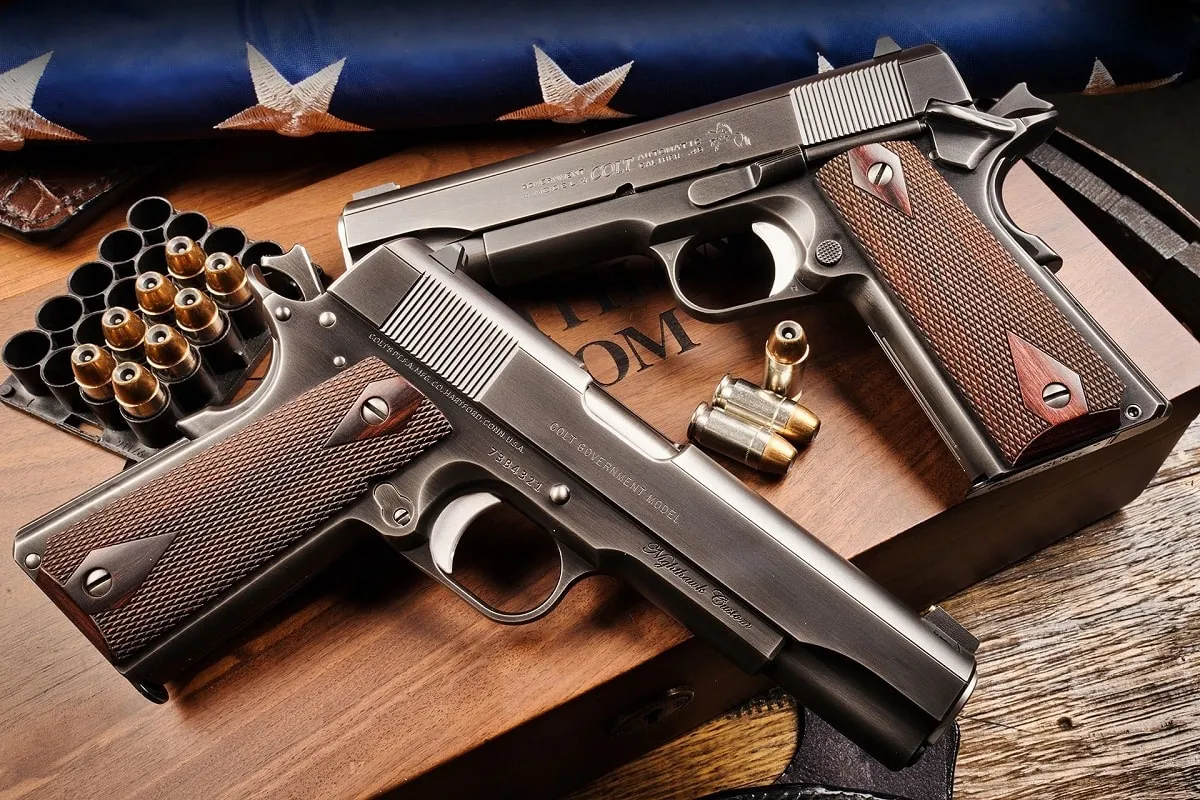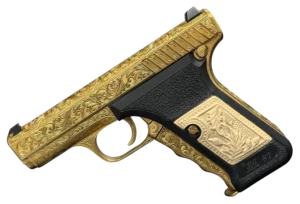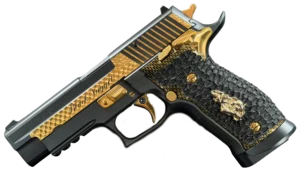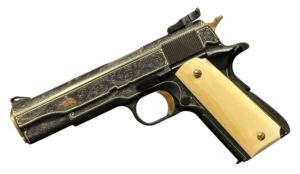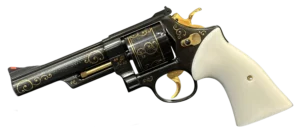Key Takeaways:
- The 1911 isn’t just a gun — it’s a legacy wrapped in steel: Designed by John Browning over a century ago, the 1911 has survived wars, technological leaps, and changing tastes — not because of nostalgia, but because it still functions effectively. Its design hits that rare sweet spot between form, function, and soul.
- It became iconic because it earned it, not because someone said it should be: From the trenches of World War I to the jungles of Vietnam, the 1911 proved itself under pressure. Soldiers trusted it. Special forces still carry it. And competitive shooters keep it in the game. You don’t get that kind of track record without being pretty damn special.
- Even in a world of polymers and red dots, the 1911 still holds its ground: Sure, it’s heavier. Fewer rounds. Needs more care. But shoot one — shoot one — and you’ll get it. That smooth trigger, that push of recoil, that mechanical honesty. It’s not for everyone, but for the people it’s for, it’s everything.
Let’s say it up front: the 1911 isn’t just a gun. It’s a legend.
Ask around. Gunsmiths, soldiers, collectors, competition shooters — everyone has a story about a 1911. Or at least an opinion. It’s one of those rare pieces of engineering that became more than the sum of its parts. It’s metal, sure, but it also carries weight in history, identity, and — weirdly enough — nostalgia.
So, how did this slab of steel and fire come to define what a handgun could be? Why are we still discussing it, carrying it, customizing it, and shooting it more than a century after it first appeared? Buckle up — this isn’t just a timeline. This is a story about a design that refused to die.
The Birth of a Game-Changer
Rewind to the late 1800s. The U.S. military was still issuing revolvers — six shots, slow reload, not the most confidence-inspiring when bullets were flying. The world was changing fast, and the military needed a sidearm that could keep up.
Enter John Moses Browning. The man had already made a name for himself designing shotguns and rifles, but what he was cooking up next would change everything.
Now, Browning didn’t just sketch out a semi-automatic pistol because it seemed calm. He saw a problem — slow, underpowered revolvers — and decided to fix it. His answer? A magazine-fed, recoil-operated semi-auto chambered in a round with actual stopping power: .45 ACP. And not coincidentally, he helped design that cartridge, too.
That pistol — the one that would become the 1911 — was reliable, simple, powerful, and, above all, it worked when it mattered.
Beating the Odds: Military Trials and Triumph
The military started looking for a new sidearm around 1906. A whole batch of pistol designs entered the ring. And the trials? Brutal. Guns were exposed to sand, mud, rain, and dust. They were fired thousands of times. Most jammed or broke down.
Browning’s pistol didn’t flinch. After years of tests, the U.S. military officially adopted it on March 29, 1911.
And just like that, the Model 1911 was born.
From there, the pistol went on to serve in the hands of U.S. troops through two world wars, Korea, Vietnam, and beyond. It was a constant — a steel companion through some of the darkest and most defining moments in American history.
Baptism by Fire: The 1911 at War
World War I was the 1911’s first real test under fire, and it passed with flying colors. Officers and NCOs carried it through the mud and terror of the trenches. In a fight where seconds mattered, the 1911’s stopping power and semi-auto action saved lives.
Then came World War II, and the 1911 was everywhere. It was in the Pacific, in Europe, in North Africa. Troops trusted it. They cleaned it with motor oil. They passed it down. They brought it home. And somehow, even in the rain, the cold, and the blood, it fired.
It stuck around for Korea. Then Vietnam. Even when the Beretta M9 replaced it as the official sidearm in 1985, the 1911 never really left. To this day, elite units — such as the Marine Corps Force Recon and Delta Force — still use updated versions.
Because when something works, it just works.
What Made the 1911 So Damn Good?
Let’s talk guts.
The original 1911 was chambered in .45 ACP — a big, slow round that hits hard and stops threats. It featured a single-stack magazine with 7 rounds (sometimes 8), a single-action trigger, and included a grip safety and a manual thumb safety.
That’s it. Nothing flashy. Just clean, intuitive design that you could trust in a firefight — or at the range.
In 1924, the military made some modifications, introducing the M1911A1. Consider a shorter trigger, an arched mainspring housing, and a longer grip safety. Small changes, but they made the gun even more comfortable and shootable.
Since then? The platform has exploded. There are 1911s available in 9mm, 10mm, .38 Super, and even 38 Special 22 LR. You’ve got compact Officer models, mid-size Commanders, and full-sized Government versions. But at their core, they’re still 1911s — same DNA, same soul.
The Colt Era — and Everyone Else
Colt was the original. They built the first 1911s and worked closely with Browning to get it just right. For decades, if you wanted a 1911, it was coming out of Hartford.
However, time passes, patents expire, and other manufacturers enter the market.
Springfield Armory, Kimber, Wilson Combat, Dan Wesson, Smith & Wesson, even SIG. Some stuck to the classic lines. Others went wild — rails, optics cuts, match triggers, complete custom jobs.
The point is, Colt may have started it, but the 1911 has become everyone’s gun now.
Why the 1911 Still Matters — Even Now
We’ve got polymer wonder-guns these days. Glocks, SIGs, HKs. They’re lighter, higher capacity, and easier to maintain. So why is the 1911 still around?
Because shooting one just feels different.
The trigger — short, crisp, almost telepathic. The recoil is more of a push than a snap—the fit in the hand, like it was carved to match human bone.
That’s why law enforcement and military units still trust them for precision work. That’s why competitive shooters run them in USPSA and IDPA. That’s why concealed carriers still bet their lives on them.
It’s not nostalgia. Its performance.
The 1911 as a Canvas: Customization Culture
If the AR-15 is LEGO for adults, the 1911 is hot rod heaven. You can tweak everything — slide, barrel, trigger, hammer, safeties, sights, grip panels, finish.
Want a chrome 1911 with ivory grips? Done.
Need a threaded barrel and RMR-ready slide? Easy.
And then there’s the gunsmithing side. A well-tuned 1911 is a thing of beauty. You feel the difference when every part fits just right. There’s a whole world of hand-fitted, hand-polished masterpieces out there — from brands like Nighthawk Custom, Ed Brown, and Les Baer.
It’s not just a gun anymore. It’s an expression.
For Collectors, It’s Gold
Original military-issued 1911s from World War I or World War II? Priceless. Especially if they’re in good shape.
But even modern collectors chase special runs — commemorative models, high-end customs, rare variants like the Korth 1911 or the Cabot Guns “Left and Right” set.
There’s something about the 1911 that makes people want to hold onto it. Maybe because it’s never just a tool, it’s a story — one you can shoot.
Evolution, Not Revolution — The 2011 and Beyond
Here’s where things get interesting.
Some folks wanted more capacity but didn’t want to leave the 1911 behind. So they made the 2011 — essentially a double-stack 1911 with a modular frame. It’s heavier, more competition-focused, and an absolute monster in sports like 3-Gun or IPSC.
STI (now Staccato), Atlas Gunworks, and others have taken the formula and turned it into something modern and beastly.
Still, you shoot one and go — yeah, this is just an evolved 1911.
Then there’s the Korth PRS — German precision, classic roots, 1911 lineage. Expensive as hell, but also maybe the smoothest thing you’ll ever pull the trigger on.
Cultural Icon, Not Just a Firearm
If you’ve watched a war movie, a western, or any action flick from the past 50 years, you’ve seen a 1911.
Dirty Harry. Saving Private Ryan. Heat. John Wick. Even video games — such as Call of Duty, Battlefield, and Resident Evil — all feature it. There’s just something cinematic about it. That profile. That slide. That authoritative clack when it chambers a round.
The 1911 doesn’t just show up. It owns the screen.
So Why Does It Still Matter?
Honestly? Because it’s still damn good.
It’s not perfect. It’s heavier than modern pistols. Lower capacity. It needs regular maintenance. But it shoots like a dream, looks like a sculpture, and carries with it a century of stories.
There’s a kind of mechanical poetry in 1911. A rhythm to the way the slide runs, the way the hammer falls. A feeling that you’re holding not just a weapon, but a legacy.
And maybe that’s the real reason the 1911 endures. It reminds us that good design doesn’t need to be replaced. It just needs to be understood, appreciated, and — occasionally — upgraded.
Final Thought
If you’ve never shot a 1911, find someone who has one and give it a go. Feel that trigger. Hear the thunk of .45 ACP. And yeah, maybe you’ll walk away with a silly grin.
Because sometimes, the old ways are the best ones.
Frequently Asked Questions
Because that’s when the U.S. military officially adopted it — March 29, 1911, the name stuck, and so did the pistol.
Weirdly enough, yeah. Although it was officially replaced by the Beretta M9 in 1985, specific units, such as Marine Force Recon or special operations groups, still operate custom 1911s. When your job calls for precision and stopping power, the old warhorse still delivers.
Depends on what you’re looking for. If you want max capacity and easy maintenance, a polymer-framed 9mm probably makes more sense. But if you care about trigger feel, accuracy, and timeless design? The 1911 still holds its own. There’s a reason people keep coming back to it — it just shoots right.
The .45 ACP round was designed with stopping power in mind — big, slow, and hits hard. Some folks swear by it, others prefer 9mm for capacity and softer recoil. These days, you can find 1911s in all sorts of calibers, so it’s a matter of personal taste (and recoil tolerance).
Think of 2011 as the 1911’s buff, modern cousin. It features a double-stack magazine for increased capacity and typically comes with a modular frame. They’re popular in competitive shooting and look a little flashier — but at heart, they’re still very much a product of the 1911’s DNA.


